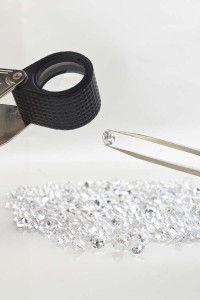What do we do now?

Although I have painted a bleak picture, I would suggest there is a great opportunity for brick-and-mortar retailers to stand out. While e-tailers offer stones and their gemmological reports as absolutes, the subjective nature of diamond grading provides jewellery stores a chance to show prospective customers this is not the case.
More importantly, though grading standards are subjective, there is a wide range of possibilities along scales, and it’s in those opportunities that real value can be found. In short, stones should be bought and sold based on what they are, rather than what grading reports indicate. What do I mean by this? Well, a buyer should be fairly comfortable in determining a stone’s grade is accurate to the diamond report presented. Over the years, we’ve found the opportunity for a real value purchase should be in trying to find stones at the higher end of a diamond’s reported grade. For example, when buying an SI1 stone, a buyer should look for a diamond that would rank it closer to a VS2, rather than an SI2. I believe jewellery retailers will need to become very good at finding these opportunities—specializing in a particular range of diamond grades is the first place to start. By that I mean they will need to learn how to accurately grade stones in this range and know what inclusions to look for that make the stone a good buy.
For instance, my brother, Kamal, and I have found that an SI2 with twinning wisps, rather than a centre inclusion, is a good buy in some unique situations, since to receive this grade the inclusion needs to be quite large or very obvious (i.e. noticeable under 10x magnification, although in many instances, it can also be partially visible to the naked eye). Alternatively, a twinning wisp in an SI2 is noticeable as a cobweb under 10x magnification, but cannot be seen when viewed with the naked eye.
As has been a theme in all of my previous articles, opportunities in buying can only be found when you actually observe and examine the stone you purchase. And so in keeping with that, I would like to share an interesting fact brick-and-mortar retailers can use the next time they find themselves competing with online retailers. Trying to interpret a gemmological report is a tough task at the best of times, but trying to make sense of the digital plot can be a nightmare. Now taking the twinning wisp example in the previous paragraph, logic and intuition may tell you a diamond plot with the minimal of information or marking is the best. While the diamond plot of the twinning-wisp stone makes the diamond undesirable on paper, it is through observation that the subjectiveness of the grades will be noticeable.
I spent my undergraduate years in university studying physics and astronomy, two subjects where we dealt with absolutes. What I came to realize is that a question with many possible answers doesn’t sit very well with me, which is why I have never felt comfortable with the subjective nature of diamond grading. Over the years, I have found that being able to sell beyond the grading report is one way to help the jewellery industry succeed. While some may disagree with my position, I’ve also come to appreciate that in not talking openly about the issues, as was the case with over-graded diamonds, no progress toward a solution can be made.
 Hemdeep Patel is head of marketing and product development of Toronto-based HKD Diamond Laboratories Canada, an advanced gemstone and diamond laboratory with locations in Bangkok, Thailand, and Mumbai, India. He also leads Creative CADworks, a 3D CAD jewellery design and production firm. Holding a B.Sc. in physics and astronomy, Patel is a third-generation member of the jewellery industry, a graduate gemmologist, and vice-president of the Ontario chapter of the GIA alumni association. Patel can be contacted via e-mail at hemdeep@hkdlab.ca or sales@creativecadworks.ca.
Hemdeep Patel is head of marketing and product development of Toronto-based HKD Diamond Laboratories Canada, an advanced gemstone and diamond laboratory with locations in Bangkok, Thailand, and Mumbai, India. He also leads Creative CADworks, a 3D CAD jewellery design and production firm. Holding a B.Sc. in physics and astronomy, Patel is a third-generation member of the jewellery industry, a graduate gemmologist, and vice-president of the Ontario chapter of the GIA alumni association. Patel can be contacted via e-mail at hemdeep@hkdlab.ca or sales@creativecadworks.ca.





